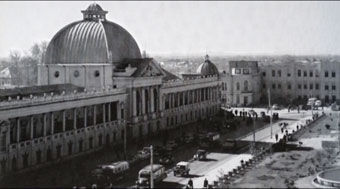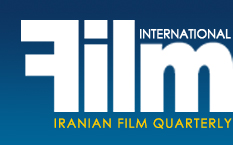|
A glance at a few documentaries on Tehran
Tehran's Symphony
by Elham Tahmasebi
|
|

Films about cities and urban life are realistic documentaries that fall within the category of urban documentaries. These films frame bits from the lives of people and cities to reflect urban way of life and show people and their varying lifestyles within the framework of their cultural, historical and political settings and picture city structure, access routes as well as urban motifs. The more these pictures are devoid of the directors' propaganda agenda, the more suitable they are for historical and anthropological studies. Walter Ruttmann and Dziga Vertov were the first documentary filmmakers who recorded their experience of city watching on black and white celluloid. Ruttmann made Symphony of a Metropolis (1927) and made an eternal documentary by recording one day in the life of Berlin. The shots of this film, which were, in some cases, similar to candid camera shots, are among the best examples of this type of filmmaking. Another example of this type of documentary filmmaking is the legendary The Man with a Camera (1929) by Dziga Vertov, the founder of cinema verite.
A tendency toward making urban documentary has been also visible in Iran, though in a sporadic way, in the works of many filmmakers. A few good examples are a series of documentaries produced by Tasvir-e Shahr Institute courtesy of the Culture and Arts Organization of the Tehran Municipality. Some of these films include: In Discontinued Streets (Pirouz Kalantari), Tehran and a Thousand Stories (Ahmad Mir-Ehsan), Tehran in Pictures (Robert Safarian), They Stage Plays in Tehran (Taha Parsa Shoja-Nouri), A City Dreaming Painting (Roshanak Sadr), The Statues of Tehran (Bahman Kiarostami) and Tehran and Cinema (Shadmehr Rastin). The executive producer of these series is Naser Onsori and their production manager is Nahid Delagah. Although these films are made-to-order and reflect a different kind of view, still all of them try to establish links between Tehran as a metropolis and various forms of arts such as photography, sculpture, theater and cinema.
These films share some of their characteristics perhaps at the order of their producers, including narrations of these films. All of them have been voiced by the filmmakers. This has been possibly done in order to avoid clichés and to make the films distinct and to create a relationship between films and the filmmakers who made them. However, this does not work in all cases. A director is a director and a narrator, is a narrator. That is unless the director does not believe that a narrator's job is not simple. In some of these films, this shortcoming has been corrected by adding other voices. Bahman Kiarostami has inserted questions as captions in order to find a way around reading them out. We will take a look at all of these films, except Tehran and Cinema, whose director would like to re-edit it. Instead, we have added Passages of Tehran to this collection although it does not belong to the series. However, it has been produced by the same producer, a Tehran Municipality affiliate.
In Discontinued Streets
Writer and director: Pirouz Kalantari
52 minutes.
This film takes a look at Tehran through a number of poems that have been written about it. The film portrays urban life in Tehran in compliance with the content of every one of those poems. The film begins with a beautiful shot of floodlight while cars are dashing back and forth. As car lights drag in darkness, the scene is ripe for the introductory scene of a documentary about poetry and the city. The filmmaker links poetry with Tehran starting from a recent piece dated 2001 and we hear a narration about the city and love as the festivity and floodlight continues. At the end, we would expect a report or an interview with a poet. Instead we see pictures of poets cut to each other in a way that it would not give them the opportunity to pose in front of the camera. Later on, we see scenes of daily life of citizens within the framework of a subway car window. The poetry read out over staring faces creates a collage of faces and words. In another scene, the film looks for some kind of link between the poets and the names of streets.
SUBSCRIBE
[Page: 90]
|
|
|
|
|
President & Publisher
Massoud Mehrabi
Editors:
Sohrab Soori
Translators:
Sohrab Soori
Behrouz Tourani
Zohreh Khatibi
Saeed Khamoush
Contributors
Shahzad Rahmati
Saeed Ghotbizadeh
Advertisements
Mohammad Mohammadian
Art Director
Babak Kassiri
Ad Designers
Amir Kheirandish
Hossein Kheirandish
Cover Design
Alireza Amakchi
Correspondents
E.Emrani & M. Behraznia (Germany)
Mohammad Haghighat (France)
A. Movahed & M. Amini (Italy)
Robert Richter (Switzerland)
F. Shafaghi (Canada)
B. Pakzad (UAE)
H. Rasti (Japan)
Print Supervisors
Shad-Rang
Noghreh-Abi
Gol-Naghsh
Subscription & Advertising Sales
Address: 10, Sam St., Hafez Ave., TEHRAN, IRAN
Phone: +98 21 66722444
Fax: +98 21 66718871
info@film-magazine.com
Copyright: Film International
© All rights reserved,
2023, Film International
Quarterly Magazine (ISSN 1021-6510)
Editorial Office: 5th Floor, No. 12
Sam St., Hafez Ave., Tehran 11389, Iran
*
All articles represent views of their
authors and not necessarily
those of the editors
|
|
|

